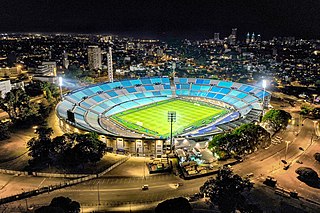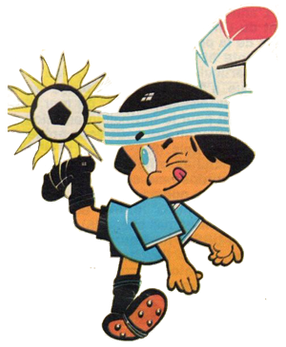
The 1930 FIFA World Cup was the inaugural FIFA World Cup, the world championship for men's national football teams. It took place in Uruguay from 13 to 30 July 1930. FIFA, football's international governing body, selected Uruguay as the host nation, as the country would be celebrating the centenary of its first constitution and the Uruguay national football team had successfully retained their football title at the 1928 Summer Olympics. All matches were played in the Uruguayan capital, Montevideo, the majority at the Estadio Centenario, which was built for the tournament.

Teófilo Juan Cubillas Arizaga is a Peruvian former footballer who played as an attacking midfielder. He was selected as Peru's greatest ever player in an IFFHS poll, in which he was also included in the world's Top 50. He was renowned for his technique, shooting ability and free kick ability.

The Chile national football team represents Chile in men's international football competitions and is controlled by the Federación de Fútbol de Chile which was established in 1895. The team is commonly referred to as La Roja. Chile has appeared in nine World Cup tournaments and were hosts of the 1962 FIFA World Cup where they finished in third place, the highest position the country has ever achieved in the World Cup.

The Peru national football team represents Peru in men's international football. The national team has been organised, since 1927, by the Peruvian Football Federation (FPF). The FPF constitutes one of the ten members of FIFA's South American Football Confederation (CONMEBOL). Peru has won the Copa América twice, Bolivarian Games 6 times, and has qualified for the FIFA World Cup five times ; the team also participated in the 1936 Olympic football competition and has reached the semi-finals of the CONCACAF Gold Cup. In the past, they were often considered 4th best in South America, after Brazil, Argentina, and Uruguay. The team plays most of its home matches at the Estadio Nacional in Lima, the country's capital.

The Bolivia national football team, also known as La Verde, has represented Bolivia in international football since 1926. Organized by the Bolivian Football Federation (FBF), it is one of the ten members of FIFA's South American Football Confederation (CONMEBOL).

Estadio Centenario is a stadium in the Parque Batlle of Montevideo, Uruguay, used primarily for football, and owned by the Montevideo Department. The stadium was built between 1929 and 1930 to host the inaugural 1930 FIFA World Cup, as well as to commemorate the centenary of Uruguay's first constitution. It is listed by FIFA as one of the football world's classic stadiums. On July 18, 1983, it was declared by FIFA as the first Historical Monument of World Football, to this day the only building to achieve this recognition worldwide.
The 1934 FIFA World Cup was the first World Cup for which teams had to qualify, after the finalists in the inaugural 1930 World Cup had participated by invitation from FIFA. With 32 teams having entered the 1934 competition, FIFA organized qualification rounds to select 16 teams for the finals. Even Italy, the host of the World Cup, had to earn its spot, the only time this has been the case. The previous champion Uruguay refused to defend its title because many European nations had declined to take part in the 1930 World Cup, held in Uruguay.
121 teams entered the 1986 FIFA World Cup qualification rounds, competing for 24 places in the final tournament. Mexico, as the hosts, and Italy, as the defending champions, qualified automatically, leaving 22 spots open for competition. The draw took place on 7 December 1983 at Zürich, Switzerland.
Listed below are the dates and results for the 1982 FIFA World Cup qualification rounds for the South American zone (CONMEBOL). For an overview of the qualification rounds, see the article 1982 FIFA World Cup qualification.
The following are the association football (soccer) events of the year 1968 throughout the world.

The 1980 World Champions' Gold Cup, also known as Mundialito, was a friendly international football tournament organized by the Uruguayan Football Association and supported by FIFA–although not officially recognized–in commemoration of the 50th anniversary of the first FIFA World Cup, which had been celebrated in 1930 at the same venue. It was held at the Centenario Stadium in Montevideo, Uruguay, from 30 December 1980 to 10 January 1981.
The 1981 CONCACAF Championship, the eighth edition of the CONCACAF Championship, was held in Honduras from 1 to 22 November. All games were played in the Estadio Tiburcio Carías Andino in Tegucigalpa. This tournament was won by the host, Honduras, who earned their first title and secured for the first time a place in the FIFA World Cup, as the tournament also served as qualification to Spain 1982. The North, Central American and Caribbean zone was allocated two places in the final tournament. This edition was marked by an upset as Mexico, traditional CONCACAF heavyweights and needing a win to go through, were eliminated by Honduras. The 0–0 tie between Mexico and Honduras qualified El Salvador to participate in the World Cup as the CONCACAF runners-up. El Salvador also became the first Central American team to qualify for more than one World Cup. This would be the last tournament which would feature a host nation for the final round.

Jorge Luis Pinto Afanador is a Colombian football manager.

Ricardo Alberto Gareca Nardi, nicknamed el Tigre and el Flaco, is an Argentine football manager and former player who was recently head coach of Vélez Sársfield. Gareca was the manager of the Peru national team from 2015 to 2022.

The 2011South American Youth Championship was a football competition for U-20 national teams in the South America (CONMEBOL). The tournament was held in Peru from 16 January to 12 February.
Jorge Góngora Montalván was a former Peruvian footballer who played for clubs Universitario de Deportes in Peru, Unión Española in Chile and the Peru national football team in the FIFA World Cup Uruguay 1930.
Jorge Ernesto Pardón García was a Peruvian footballer who played for Peru at the 1930 FIFA World Cup. He also played for Sporting Cristal.
Arturo Fernández Meyzán was a Peruvian football defender who played for Peru in the 1930 FIFA World Cup. He also played for Universitario de Deportes, and for Peru at the 1936 Summer Olympics.

Roberto Orlando Mosquera Vera is a Peruvian football manager and former player who played as a forward.











